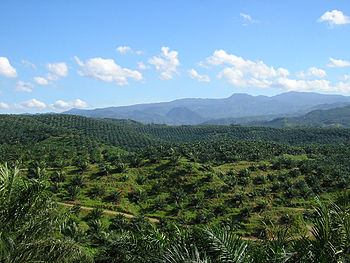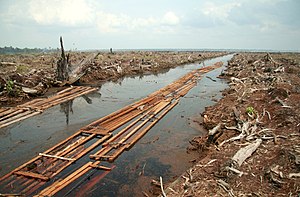Palm oil production is important to the economy of Indonesia as the country is the world's biggest producer and consumer of the commodity, providing about half the world supply.[1] Oil palmplantations stretch across 6 million hectares (roughly twice the size of Belgium). Indonesia plans by 2015 to add 4 million additional hectares towards oil palm biofuel production.[2]As of 2012, Indonesia produces 35 percent of the world's certified sustainable palm oil (CSPO).[3]


A palm oil plantation in Cigudeg, Bogor.
In addition to servicing traditional markets, Indonesia is looking to put more effort into producing biodiesel. China and India are the major importers of palm oil, accounting for more than a third of global palm oil imports.
Production
Production of palm oil in Indonesia has, since 1964, recorded a phenomenal increase from 157, 000 tonnes to 33.5 million tonnes in 2014.[4] Palm oil accounts for 11% of Indonesia's export earnings of $5.7bn. Maintaining its status as the world’s largest producer of palm oil, Indonesia has projected a figure of 40 million tonnes by 2020. In this context, the global production figure given by Food and Agricultural Organization (FAO) was 50 million tonnes for 2012, double the production of 2002.[5] This increase is reflected also in increases of Indonesia’s production of palm oil for the same period, from 10.300 million tonnes in 2002 and 28.50 million tonnes in 2012.[4]
The remains of a peat forest in Indragiri Hulu, Riau Province, Indonesia to make way for oil palm plantation.
The entire production of the oil is derived from Indonesia's rainforest which ranks third in the world, the other two being in the Amazon and Congo basins. According to the Indonesian Palm Oil Association, one third of this production is attributed to smallholder farmers and the remaining to the multinationals. Palm trees that were planted about 25 years ago have an annual average production rate of four tonnes of oil per hectare and now there are plans to increase this by introducing newer varieties which could double the production rate per hectare.[5]
Borneo and Sumatra are the two islands which account for 96 percent of Indonesia’s palm oil production.[6] As of 2011, area under oil palm plantations was 7.8 million hectares of out of which 6.1 million ha were productive plantations under harvest and thus Indonesia has become the global leader in crude palm oil (CPO) production. According to the World Bank reports nearly 50% of CPO produced in the country is exported in an unprocessed form, while the remaining is subject to processing into cooking oil out of which about 50% is exported and the balance consumed is locally[7]
Uses
Palm oil is an essential ingredient in the manufacture of myriad of products such as many types of chocolates, chewing gum, lipstick, washing powder,[5] doughnuts, soap, and biodiesel.[6] Palm oil use in Asia is very wide as cooking medium and for noodles which has created a $44 billion industry. According to trade reports one third of palm oil production in the world is exported to China and India.[6]
Companies
Major local and global companies are building mills and refineries, including PT Astra Agro Lestari Terbuka (150,000 tpa biodiesel refinery), PT Bakrie Group (a biodiesel factory and new plantations), Surya Dumai Group (biodiesel refinery).[8]
Cargill (sometimes operating through CTP Holdings of Singapore) is building new refineries and mills in Malaysia and Indonesia, expanding its Rotterdam refinery to handle 300,000 tpa of palm oil, acquiring plantations in Sumatra, Kalimantan, and Papua New Guinea.[citation needed]
Robert Kuok's Wilmar International Limited has plantations and 25 refineries across Indonesia, to supply feedstock to new biodiesel refineries in Singapore, Riau, Indonesia and Rotterdam.[8]
Musim Mas Group has plantations and refineries in Malaysia and Indonesia - Kalimantan, Medan etc. although they are headquartered in Singapore.
In August 2011, the governor of Aceh issued a permit for Indonesian palm oil firm PT Kallista Alam to develop some 1,600 hectares in Tripa.[9] Indonesian palm oil producer Triputra Agro Persada will reportedly increase its planted area by about two-thirds from 2013 by 2015.[10]
Environmental Impact
Further information: Social and environmental impact of palm oil
Wild orangutan spotted in Kutai National Park, Borneo, Indonesia.
Sumatran tiger (Panthera tigris)
A major environmental threat that palm oil production faces is the destruction of rainforests (source for palm oil) in Indonesia and Malaysia (according to reports deforestation accounted for a minimum of 8 million hectares of forest land in Indonesia[7]). This deforestation has also resulted in serious threat to endangered species such as Borneo pygmy elephants, Sumatran elephants, Sumatran tigers, Sumatran rhinoceroses, and both species of orangutan which live in these forests. Also reported are human rights abuse in the form of using child labour and debt bondage in the plantations of Borneo and Sumatra.[6]
According to a Greenpeace report palm oil production contributed deforestation of 25% of forest land in Indonesia during the period 2009 -2011, which has proved to be a serious threat to the habitat of the orangutan, the Sumatran elephant, and the Sumatran tiger which are for critically endangered species.[5][clarification needed]
In Kalimantan, deforestation for oil palm plantation development is said to endanger the living space of indigenous tribes and orangutans.[11][12]
Remedial measures
A government moratorium on the clearing of new forest has become effective from 2011 which will be effective till 2015. Of the total logging in Indonesia, up to 80% is reported to be performed illegally.[13]
The Indonesian Palm Oil Board has planned to adopt new planting materials on the older plantations which could double the yield from the present annual rate of four tonnes of oil per hectare. In addition, the government will encourage development of degraded lands found suitable to grow palm trees. This area is reported to be 14 million hectares in the four provinces of Kalimantan, on the Indonesian part of the Borneo island.[5]
See also
- Deforestation in Indonesia
- Environmental issues in Indonesia
- List of Goods Produced by Child Labor or Forced Labor
References
- ^ McClanahan, Paige (11 September 2013). "Can Indonesia increase palm oil output without destroying its forest? Environmentalists doubt the world's biggest palm oil producer can implement ambitious plans without damaging woodland". The Guardian. Retrieved 22 September 2013.
- ^ "Palm oil". Greenpeace. Retrieved 22 September 2013.
- ^ Sarif, Edy (17 June 2011). "Malaysia expected to maintain position as world’s largest producer of Certified Sustainable Palm Oil". The Malaysian Star. Retrieved 22 September2013.
- ^ a b "Indonesia Palm Oil Production by Year". Indexmundi.com. Retrieved 22 September 2013.
- ^ a b c d e "Can Indonesia increase palm oil output without destroying its forest?". The Guardian. 11 September 2013. Retrieved 22 September 2013.
- ^ a b c d "Indonesia's Palm Oil Industry Rife With Human-Rights Abuses". Businessweek. 18 July 2013. Retrieved 23 September 2013.
- ^ a b "Fact File – Indonesia world leader in palm oil production". Ceentre for International Forest Research. 8 July 2013. Retrieved 23 September 2013.
- ^ a b Corporate power: The palm-oil-biodiesel nexus Grain 2007
- ^ Stop Burning Rain Forests for Palm Oil; The world's growing appetite for cheap palm oil is destroying rain forests and amplifying climate change 6 December 2012 Scientific American
- ^ Benny Subianto Forbes 2013
- ^ "Finding Their Forests Flush With Foes, Provincial Tribes Push for Logging Ban". Jakarta Globe. 10 October 2010.
- ^ "Palm oil threat to Indonesia's orangutans". BBC News. 27 December 2011.
- ^ Riskanalys av glas, järn, betong och gips 29 March 2011. s.19–20 (Swedish)
External Links
Media related to Oil palm plantations in Indonesia at Wikimedia Commons
Wikipedia








No comments:
Post a Comment